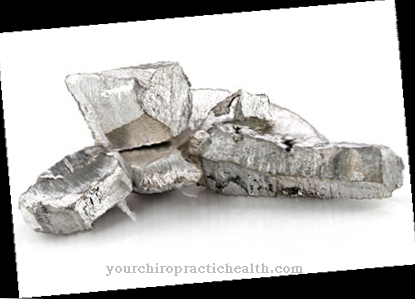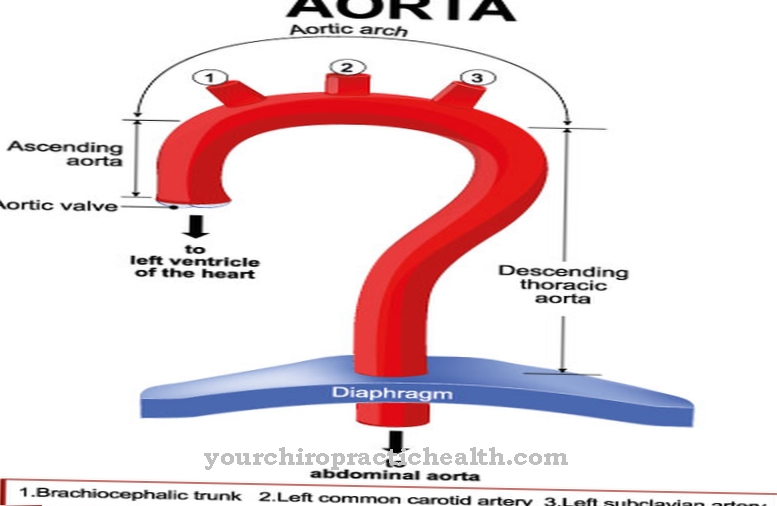The Supraspinatus tendon syndrome describes a chronic pain syndrome of the shoulder muscles. It occurs mainly in advanced age after wear processes, but is favored by certain anatomical characteristics or injuries.
What is supraspinatus tendon syndrome?

© bilderzwerg - stock.adobe.com
At the Supraspinatus tendon syndrome the tendon of the supraspinatus muscle (upper bone muscle) is degeneratively changed. This results in chronic, movement-dependent pain, especially when the arm is spread apart.
The supraspinatus tendon syndrome is one of the individual diseases that are summarized under the umbrella term "shoulder impingement syndrome".
In addition to the tendon of the supraspinatus muscle, surrounding structures such as bursa can also be affected by degeneration and inflammation.
causes
The Supraspinatus tendon syndrome can be explained by the anatomical location and the particular susceptibility of the supraspinatus muscle to degeneration. The muscle is part of the so-called rotator cuff, which holds the humerus in the joint socket of the shoulder blade and enables its range of motion.
The supraspinatus muscle extends from the posterior upper shoulder blade to the humerus. The tendon has to pass under the bony roof of the shoulder (acromion) and under a ligament between the roof of the shoulder and the raven-beak process (ligamentum coracoacromiale). This natural constriction can be narrowed additionally due to individual anatomical conditions, after fracture healing or due to inflammation.
In addition, the supraspinatus tendon is physiologically exposed to high pressure and friction loads and is therefore susceptible to degenerative wear over the course of life. Along with the tendon itself, its supply structures also degenerate: there are circulatory disorders and increasingly poorly functioning repair measures, until finally a fully developed supraspinatus tendon syndrome is present.
Typical symptoms & signs
- Arm pain, joint pain
- Restrictions on movement
- Shoulder pain when lifting your shoulder or arms
Diagnosis & course
First symptom of one Supraspinatus tendon syndrome are pain when actively spreading (abducting) the arm, especially against resistance. Since the pain is most severe at an average degree of distraction of approx. 70-120 degrees, one speaks of a "painful arch".
Typical of a supraspinatus tendon syndrome are pressure pain at the anterior joint space and the pain radiating into the outer upper arm. The development of a supraspinatus tendon syndrome usually takes place in phases: painful irritation alternates with phases of - conscious or unconscious - rest, through which a temporary improvement can be achieved.
Over time, rest and regeneration become more and more ineffective and the pain-free phases become shorter and shorter, until the pain and movement restrictions are finally chronic. By protecting the supraspinatus muscle, muscular imbalances also develop, which promote the head of the humerus to stand up and the supraspinatus tendon to narrow further - a vicious circle.
To diagnose supraspinatus tendon syndrome, it is first determined with which movements, in which arm position and to what extent the pain occurs. The actual degeneration processes cannot be clearly seen in the X-ray image - but possibly bony growths after fracture healing, calcifications or an already existing raised position of the humerus head provide indications of a supraspinatus tendon syndrome.
The shoulder muscles and the surrounding soft tissue structures can be better assessed in an ultrasound examination. Magnetic resonance tomography is sometimes used. A reflection (arthroscopy) of the shoulder joint - in the past often part of diagnostics - is now one of the therapeutic means due to improved imaging.
Complications
The supraspinatus vision syndrome increasingly causes movement restrictions in its course. As the disease progresses, the phases of pain become longer and longer until they finally develop into a chronic syndrome. The affected person then usually performs evasive movements, which can lead to premature joint wear and other misalignments.
The alternation between rest and pain phases also causes muscular imbalances, which can lead to the head of the humerus rising up. This can lead to a further narrowing of the supraspinatus tendon. In the long term, the chronic pain syndrome can lead to a stiffening of the affected tendon and the surrounding bones and joints.
Such a severe course is usually associated with psychological suffering, which further restricts the well-being of the person concerned.Surgical complications are possible in the treatment of supraspinatus vision syndrome. This can lead to bleeding and inflammation in the area of the procedure.
In individual cases, nerve cords are injured, which can lead to paralysis. The conservative therapy methods - i.e. cold and heat therapy as well as physiotherapy - occasionally cause temporary discomfort. Circulatory disorders, tension, bruising or dizziness are typical. Drug treatment is associated with other side effects and interactions.
When should you go to the doctor?
In the case of supraspinatus tendon syndrome, the person affected is dependent on a visit to a doctor. It cannot heal independently, so a visit to a doctor must always take place to alleviate the symptoms and prevent further complications.
The earlier a doctor is consulted for supraspinatus tendon syndrome, the better the further course of the disease is usually. A doctor should be consulted with this disease if there is severe pain in the shoulders. This pain occurs for no particular reason and does not go away on its own. They can also occur in the form of stress pain or pain at rest and have a negative effect on the quality of life. Furthermore, severe restrictions in movement can indicate the supraspinatus tendon syndrome and should also be examined by a doctor.
As a rule, an orthopedic surgeon or general practitioner can be seen with this disease. The further course always depends on the underlying disease, so that no general prediction can be made. As a rule, the life expectancy of the person affected is not reduced by this disease.
Treatment & Therapy
Treatment of the Supraspinatus tendon syndrome can still be done conservatively in the initial stages. The spectrum of conservative therapy methods includes cold or heat therapy, diadynamic currents for muscle relaxation, medication for pain relief and anti-inflammatory measures, as well as physiotherapy and manual therapy.
The basic principle is to avoid heavy loads on the supraspinatus tendon, but at the same time to secure the range of motion of the shoulder joint and to avoid muscular imbalances. Initially, an inpatient therapy program in an orthopedic rehabilitation facility can be useful. The patient can only keep the pain symptoms in check over the long term if he then regularly uses the exercises he has learned at home.
If the supraspinatus tendon syndrome proves to be resistant to all conservative attempts at therapy, surgery must be carried out: There are various surgical approaches here, but all of them aim to expand the space under the canopy. The operation of a supraspinatus tendon syndrome is now mostly performed arthroscopically with a very low surgical risk.
You can find your medication here
➔ Medicines for joint painprevention
A prevention of the Supraspinatus tendon syndrome is difficult because the favoring anatomical factors cannot be avoided. However, the course of a supraspinatus tendon syndrome can be positively influenced by taking pain seriously and combating it early on using appropriate conservative therapy methods.
Aftercare
If the supraspinatus tendon syndrome is treated surgically, special follow-up care is required. The patient usually spends the first three days after the procedure in the hospital. Then the affected arm is immobilized for a period of four to six weeks using an arm bandage. This is a special arm cushion, which is also known as an abduction bandage.
For smaller activities, the patient can take his arm out of the bandage right from the start. However, it is necessary to consistently put on the arm pillow during the night. In this way, tendon overloads that happen unintentionally can be counteracted. The abduction bandage may also be taken off to take care of the body. However, intensive elbow movements should be avoided.
After around eight weeks, the rotator cuff of the shoulder is largely resilient again. This gives the option of post-treatment to rebuild mobility and strength of the affected arm. For this purpose, rehabilitation measures take place, which the patient carries out on an outpatient basis. They usually take at least three months to complete.
About two months after the surgery, you can go running again and after four to six months you can play ball sports again. To treat postoperative pain, the patient is given a pain catheter and local intermittent treatments with ice, which have anti-inflammatory effects.
You can do that yourself
Chronic pain syndromes such as supraspinatus tendon syndrome can be treated by a number of self-help measures.
First of all, it is important to protect the affected limb. The injured tendon should not be subjected to heavy loads for at least 14 days. The tendon can be cooled externally, as the cold slows down any inflammation and relieves pain. After the acute symptoms have largely subsided, warmth is recommended. In connection with moderate exercise, warm pads or compresses stimulate the metabolism and thus contribute to a quick recovery. Sport can be started again when the pain has completely subsided and the doctor gives his okay. Then gentle sports such as swimming or slow walking are particularly suitable.
The supraspinatus tendon syndrome usually progresses progressively. Therefore, the accompanying measures must be retained in the long term. A healthy lifestyle reduces chronic pain and improves well-being. Patients suffering from supraspinatus tendon syndrome should consult their doctor, who can provide precise treatment options. He may recommend attending a shoulder school, through which the patient learns to move the shoulder below the pain threshold.



.jpg)
.jpg)






















